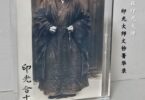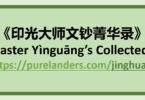以火化不耽着身为我
[203] With Cremation Not [Having] Infatuation [With] Body As Self
自佛法东来,僧皆火化。而唐宋崇信佛法之高人达士,每用此法。
Since [the] Buddha’s Dharma [to the] East came, monastics all [use] cremation. Then [in the] Táng [and] Sòng [Dynasties], very capable persons [and] scholars [with] thorough understanding [who] have faith [in the] Buddha’s Dharma, very often use this method.
[Note 1: Śākyamuni Buddha (释迦牟尼佛) personally set the example of not being attached to his deceased body, by having cremation of his body with his supernormal powers (神通力) after entering Parinirvāṇa (入涅槃). Our being agreeable to the body to be cremated expresses non-attachment to the body too.]
以佛法重神识,唯恐耽着身躯,不得解脱。焚之,则知此不是我,而不复耽着。又为诵经念佛,期证法身。
With [the] Buddha’s Dharma’s emphasis [on the] consciousness, only fearing infatuation [with the] body, not attaining liberation. Burning it, then knowing this is not self, then not again [having] infatuation [with it]. Also with recitation [of] sūtras [and] mindfulness [of the] Buddha[‘s name], hoping [there will be] realisation [of the] Dharma Body.
[Note 2: When dying and deceased, there should be renunciation of the then useless body, only with attention on how to resettle the consciousness, ideally in Āmítuófó’s (阿弥陀佛) Pure Land (净土). This should be expressed with the Main Practice (正行) of utmost sincere mindfulness of Āmítuófó’s name with Aspiration (愿) to be reborn in his Pure Land.]
[Note 3: Attachment to the failing or failed body as one’s ‘true’ self (when it is impermanent [无常] and unsubstantial [无我]) will trap one within the cycle of birth and death. As a Supportive Practice (助行), sūtras recited should ideally be directly related to the Pure Land teachings, such as the Amitābha Sūtra《阿弥陀经》, which teaches and reminds on doing the Main Practice above.]
[Note 4: With cremation, even those once attached to their bodies will know that they are not synonymous with their bodily remains. This is so as their consciousnesses will still be present despite destruction of their bodies, with the ability to leave their remains too.]
[Note 5: Although there is a rather common ‘custom’ of yelling for the consciousness of the deceased to leave the body (in case still attached to it physically) before cremation begins, the consciousness can be (neither) burnt (nor buried). If one’s consciousness is near an unpleasant element, there will be instinctive and quick moving away from it, even if without others’ warnings.]
[Note 6: What missing from the ‘yelling’ above is a sense of direction. This can be ‘yelled’ instead as final guidance (开示) before cremation – ‘Let go of the useless body. Only be wholeheartedly mindful of the Buddha, until you see the Buddha, to follow the Buddha, to be reborn in his Pure Land, where there will only be ultimate bliss, with no more suffering! Āmítuófó…’ (放下没有用的身体。只要一心念佛,直到见佛,跟佛,往生到他那没有苦的极乐世界!阿弥陀佛… ) Then recite the Buddha’s name until cremation is completed.]
[Note 7: Those without understanding and practice of mindfulness of the Buddha’s name, thus without a sense of direction, might still be attached to their bodily remains, in terms of corpses in coffins or ashes in urns. (This explains hauntings around these receptacles.) Ancestral tablets (神主牌位) with their names and/or pictures might be attached to as well. Such attachments should be dissuaded in advance by sharing on how mindfulness of Buddha will lead to realisation of the true body, in terms of the Dharma Body, (as shared by all Buddhas, that pervade all space and time), via reaching of Pure Land for perfecting cultivation.]
净土宗十三祖印光大师
Pure Land Tradition’s 13th Patriarch Great Master Yìnguāng
《印光法师文钞》(续编):灵岩普同塔记;
Dharma Master Yìnguāng’s Collected Writings (Second Compilation): Língyán [Monastery’s] Universally Same Pagoda’s Record;
印光大师文钞菁华录(第两百零三则):四、论生死事大:丙、示临终切要(第十三则)
Record [Of] Great Master Yìnguāng’s Collected Writings’ Essence (203rd Short Section): 4th [Chapter]: Discussion [On] Births’ [And] Deaths’ Great Matter: Third, Guidance [On When] Approaching [Life’s] End’s Definite Essentials (13th Short Section)
[Ref: #203 / 4.3.13]
Namo Amituofo : Translation and notes by Shen Shi’an
下一部分
Next Part:
火葬最易处理身躯
[204] Cremation Is Easiest For Handling The Body
https://purelanders.com/2022/07/19/204-cremation-is-easiest-for-handling-the-body
上一部分
Previous Part:
丧礼全素,开示念佛
[202] Funerals Should Be Completely Vegetarian, With Guidance And Mindfulness Of Buddha
https://purelanders.com/2022/07/20/202-funerals-should-be-completely-vegetarian-with-guidance-and-mindfulness-of-buddha
完整典籍
Complete Text:
《印光大师文钞菁华录》
Record Of Great Master Yìnguāng’s Collected Writings’ Essence
https://purelanders.com/jinghualu




